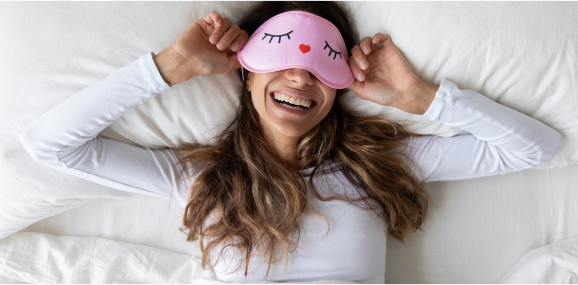Side sleeping is one of the most popular sleep positions for numerous reasons. Many people find it to be the most comfortable sleeping position, though their reasons will all be different. Every person is different, and every body is different.
Below, we’ll cover several of the benefits that this common sleep position offers. We’ll also review why the advantages of side sleeping, as well as the correct side to sleep on, will depend on your individual situation.
Why Should I Change Sleeping Positions?
If your bed itself is perfectly comfortable but you’re still not getting great sleep, your sleeping position may be the culprit.
There is no right or wrong sleeping position, but some positions support more health benefits while others carry certain risks. For instance, stomach sleeping is known to cause lower back discomfort, shoulder pain, neck pain, and more. Similarly, back sleeping can worsen acid reflux and exacerbate snoring and even obstructive sleep apnea.
Overall, the best sleeping position for you is the one that will allow you a minimum of seven hours of uninterrupted rest.
If switching from being a back sleeper or stomach sleeper to a side sleeper helps your body feel at ease, it’s worth a shot. As long as you’re using a supportive pillow and you don’t wake up feeling achy, you’re on the right track.
Are There Benefits to Sleeping on Your Side?
Side sleeping is a more neutral position than other sleep postures, which means that it may not exacerbate health problems like low back pain and digestive ailments.
If snoring, heartburn, an upset stomach, sleep apnea, or pregnancy-related discomfort are keeping you from sleeping, you’ll probably find that rolling onto your side and adopting a relaxed fetal position is a huge game-changer.
Do you suspect you have a sleep disorder like insomnia, restless leg syndrome, or sleep apnea? If so, make sure you see a medical professional — ideally a specialist at a sleep foundation — before making any changes to your sleep habits.
Eliminate Snoring and Improve Sleep Apnea
If you snore loudly, your partner has probably remanded you to the couch on more than one occasion. If you sleep alone, though, you might not know if you snore. Waking up with a dry mouth or a vaguely achy throat could be a sign that you spent the better part of the night snoring.
Snoring happens when your tongue muscle relaxes and slips back into your throat, slightly obstructing your airway and making it more difficult to breathe.
Sleeping on your side can significantly improve the situation. When your tongue relaxes in this position, it rests against your cheek. This leaves your throat unobstructed and makes it easier to breathe without snoring.
People with mild sleep apnea may also find that side sleeping nearly eliminates the issue.
Supporting Digestive Health
Lying on your back can negatively impact your digestive system. You’re also more likely to feel the effects of heartburn, especially if you’ve recently eaten something spicy or greasy. Lying on your side can mitigate the effects of heartburn and constipation by improving the way your gut naturally moves.
When You Might Vomit
If you’re sick or nauseated, lying on your side can prevent gravity and your body weight from pushing down on your stomach. Lying on your left side can help to reduce the chances of choking in the event that you suddenly vomit. It’s far safer than lying flat on your back, which can leave your airway vulnerable.
Keeping Your Growing Baby Safe During Pregnancy
Pregnancy puts a lot of strain on the human body. Your blood volume increases, your need for oxygen increases, and your heart has to work harder to make sure both you and your baby stay healthy.
When pregnant women sleep on their backs, the weight of the baby compresses their circulatory system and affects their blood flow. When they shift to the side, though, it’s almost as though the growing baby is lying in bed with them, rather than on them.
Which Side Should You Sleep On?
If you’re otherwise healthy, you can choose whichever side feels more comfortable and leads to better sleep. If you’re side sleeping to alleviate certain symptoms, though, it’s important to lay on the side that correlates to relief. Sleeping on the wrong side might make you feel worse, and that’s the exact opposite of what you’re trying to accomplish.
Sleep on Your Left Side for Heartburn and Digestive Issues
Whether you live with GERD or occasionally experience heartburn, you know how difficult it is to sleep with acid rising in your esophagus. Sleeping on your left side can help to promote symptom relief. Generally, people with GERD report experiencing fewer nighttime disturbances when they choose to sleep on their left side.
If you have heartburn and found that your symptoms were more intense when you slept on your side, it’s probably because of the side you slept on. Sleeping on your right side might make your symptoms worse.
While lying on your left side might provide you with some symptom relief, it’s important to remember that a sleeping position can’t be a cure-all for GERD or heartburn. If you frequently have heartburn, you’ll want to avoid spicy and greasy foods before bedtime, drink plenty of water, and speak to a doctor about a comprehensive treatment plan.
All in all, though, you might find that a better sleep posture is a great complement to your over-the-counter or prescription GERD medication.
Sleep on Your Left Side When Pregnant
When you’re pregnant, blood needs to flow continuously and easily from your heart to your uterus to your fetus and back again. Lying on your left side will leave this path unobstructed. It also keeps your baby from putting stress or pressure on your internal organs for prolonged periods of time.
Pregnancy comes with a lot of temporary discomforts. It’s common to wake up throughout the night to switch positions. Unfortunately, lying on your back will place more strain on your body, and lying on your stomach will eventually become impossible.
If you’re struggling to get comfortable on your left side, try switching to your right side for a little while. If you’re comfortable, stay there for the rest of the night. If you feel the need to move again, switch back to your left side.
Pregnant people can also try things like pregnancy pillows, which are designed for side sleepers, to make sleep more comfortable. They contour to your entire body and provide support where you need it most, allowing you to enjoy as much uninterrupted sleep as possible.
Sleep on Your Right Side for Cardiovascular Concerns
If you have a condition like heart failure or heart disease, or if you find it difficult to breathe at night, you should avoid sleeping on your left side. When you sleep on your left side, it’s difficult for your overburdened heart to properly pump blood throughout your body. Sleeping on your right side allows gravity to help your heart work.
If your doctor suggests a specific sleeping position, medication, or bedtime device, you should always follow those recommendations. If you know you feel more comfortable sleeping on your right side, mention that to your doctor.
How To Sleep on Your Side
If you’ve always been a side sleeper and you’re already comfortable, you’ve hit the jackpot. If you’re looking to start sleeping on your side, though, you might need to change your bedtime routine a little bit.
When you change your sleeping position, you’ll probably find that your current mattress and pillows aren’t as accommodating. Sleeping on your side changes what your body needs to stay comfortable through the night.
Keep Your Body Aligned
It can be nearly impossible to keep yourself in a perfectly symmetrical position all night long. The goal is to find a position that’s as close to symmetrical as possible. You want your joints to be in line with each other, with your knees, elbows, and shoulders all at the same level. Your neck and chin should be straight.
Lying down in this position might feel a little strange and robotic at first. But if your mattress and pillow provide the right support, you’ll soon be able to relax fully in your new position.
Choose a Mattress for Side Sleepers
Medium-firm mattresses are often the best option for side sleepers. Mattresses should be replaced every ten years — and even sooner if they begin sagging or become damaged.
When shopping for the best mattress for your sleep position, you’ll want to try a few and decide on the one that provides you with the best support.
If you’re not in the market for a whole new mattress, try a medium-firm mattress topper. Memory foam mattress toppers are often a great (and less expensive) way to significantly adjust the comfort of your mattress.
Pick the Right Pillow
The wrong pillow can leave side sleepers waking up with a sore or achy neck. The best pillow is one that will keep your spine aligned while your muscles are fully relaxed.
If you’re pregnant and side sleeping, pregnancy pillows are designed for that exact purpose. A type of large body pillows, pregnancy pillows come in several different shapes and are designed to support your head while cradling the rest of your body. The lower portion of the pillow should fit comfortably between your legs when you lay down.
Pro tip: You don’t actually need to be pregnant to use a pregnancy pillow. Many people who have never been pregnant find that they enjoy the all-encompassing support that pregnancy pillows provide.
If you’re looking for a more traditional pillow for a good night’s sleep, there are plenty of pillows designed specifically for side sleepers. These pillows provide support to the head and neck, which is crucial for side sleepers. Oftentimes, these pillows are specifically marketed as ideal for side sleepers.
Many side sleepers find that placing a pillow between their knees helps to keep their spine aligned while they sleep. You might appreciate the extra cushion if you experience joint pain or back pain.
Keep Yourself Comfortable
Once you get your mattress and your pillow sorted out, you’ll need to find a side sleeping position that feels comfortable and secure.
That’s where the Hug Sleep Pod becomes valuable. The Hug Sleep Pod is like a combination of a sleeping bag and a swaddle. You snuggle into the breathable, lightweight cocoon, and it provides gentle four-way compression that holds your body like a hug.
Many people find this sensation to be calming since the feeling of an embrace usually makes us feel more secure and relaxed. It might also help hold you in the perfect sleep position all night long.
Side Sleeping Can Be Good For You
As long as you’re sleeping on the appropriate side and your sleeping environment is designed to accommodate side sleeping, you’ll probably find that it’s the most comfortable sleeping position for you.
Get a good mattress and a supportive pillow. Then, if you need a little extra help getting comfortable, we’ll be here to give you a goodnight Hug.
Sources:
Choosing the Best Sleep Position | Johns Hopkins Medicine
Sleep During Pregnancy: Follow These Tips | Mayo Clinic
Body Position Affects Recumbent Postprandial Reflux | PubMed

































500,000+ happy customers